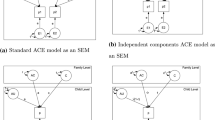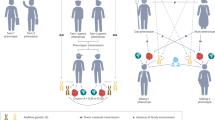Abstract
Since the publication of the first edition of this handbook (Cattell, 1966), behavior genetics has become almost completely multivariate in character. This development was inevitable given the nature of the research, conceptualization of the problems under investigation, advances in multivariate methodology, and the advent of fast computers.
Access this chapter
Tax calculation will be finalised at checkout
Purchases are for personal use only
Preview
Unable to display preview. Download preview PDF.
Similar content being viewed by others
References
Aman, M. G., and Singh, N. N. Specific reading disorders: Concepts of etiology reconsidered. In K. D. Gadow and I. Bailer (Eds.), Advances in learning and behavioral disabilities. Vol. 2. Greenwich, Conn.: JAI Press, 1983, pp. 1–47.
Bartlett, M. S. The goodness of fit of a single hypothetical discriminant function in the case of several groups. Annals of Eugenics, 1951, 16, 199–214.
Benton, A. L. Developmental dyslexia: Neurological aspects. In W. J. Friedlander (Ed.), Advances in neurology. Vol. 7. New York: Raven Press, 1975, pp. 1–43.
Bock, R. D., and Petersen, A. C. A multivariate correction for attenuation. Biometrika, 1975, 62, 673–678.
Bock, R. D., and Vandenberg, S. G. Components of heritable variation in mental test scores. In S. G. Vandenberg (Ed.), Progress in human behavior genetics. Baltimore: Johns Hopkins Press, 1968, pp. 233–260.
Boomsma, D. I., and Molenaar, P. C. M. The analysis of repeated measures twin designs. Behavior Genetics, 1985, 15, 585 (Abstract).
Cantor, R. M. A multivariate genetic analysis of ridge count data from the offspring of monozygotic twins. Acta Geneticae Medicae et Gemellologiae, 1983, 32, 161–207.
Carey, G. A general algorithm for the solution of predicted covariances in linear models in genetics. Behavior Genetics, 1985, 15, 586 (Abstract).
Cattell, R. B. The Multiple Abstract Variance Analysis equations and solutions: For nature—nurture research on continuous variables. Psychological Review, 1960, 67, 353–372.
Cattell, R. B. (Ed.) Handbook of multivariate experimental psychology. Chicago: Rand McNally, 1966.
Clifford, C. A., Hopper, J. L., Fulker, D. W., and Murray, R. M. A genetic and environmental analysis of a twin family study of alcohol use, anxiety, and depression. Genetic Epidemiology, 1984a, 1, 63–79.
Clifford, C. A., Murray, R. M., and Fulker, D. W. Genetic and environmental influences on obsessional traits and symptoms. Psychological Medicine, 1984b, 14, 791–800.
Cloninger, C. R., Rice, J., and Reich, T. Multifactorial inheritance with cultural transmission and assortative mating. II. A general model of combined polygenic and cultural inheritance. American Journal of Human Genetics, 1979, 31, 176–198.
Crawford, C. B., and DeFries, J. C. Factor analysis of genetic and environmental correlation matrices. Multivariate Behavioral Research, 1978, 13, 297–318.
DeFries, J. C., Plomin, R., Vandenberg, S. G., and Kuse, A. R. Parent-offspring resemblance for cognitive abilities in the Colorado Adoption Project: Biological, adoptive, and control parents and one-year-old children. Intelligence, 1981, 5, 245–277.
DeFries, J. C., Vogler, G. P., and LaBuda, M. C. Colorado Family Reading Study: An overview. In J. L. Fuller and E. C. Simmel (Eds.), Perspectives in behavior genetics. Hillsdale, N.J.: Lawrence Erlbaum Associates, 1986, pp. 29–56.
Eaves, L. J. Twins as a basis for the causal analysis of human personality. In W. E. Nance, G. Allen, and P. Parisi (Eds.), Progress in clinical and biological research: Twin research, part A. New York: Liss, 1978, pp. 151–174.
Eaves, L. J., and Gale, J. S. A method for analyzing the genetic basis of covariation. Behavior Genetics, 1974, 4, 253–267.
Eaves, L. J., Martin, N. G., and Eysenck, S. B. G. An application of the analysis of covariance structures to the psychogenetical study of impulsiveness. British Journal of Mathematical and Statistical Psychology, 1977, 112, 819–825.
Eaves, L. J., Last, K. A., Young, P. A., and Martin, N. G. Model-fitting approaches to the analysis of human behaviour. Heredity, 1978, 41, 249–320.
Eaves, L. J., Long, J., and Heath, A. C. A theory of developmental change in quantitative phenotypes applied to cognitive development. Behavior Genetics, 1986, 16, 143–162.
Finucci, J. M. Genetic considerations in dyslexia. In H. R. Myklebust (Ed.), Progress in learning disabilities. Vol. 4. New York: Grune & Stratton, 1978, pp. 157–167.
Fulker, D. W. Extensions of the classical twin method. In B. Bonné-Tamir, T. Cohen, and R. M. Goodman (Eds.), Human genetics, Part A: The unfolding genome. New York: Liss, 1982, pp. 395–406.
Fulker, D. W., and DeFries, J. C. Genetic and environmental transmission in the Colorado Adoption Project: Path analysis. British Journal of Mathematical and Statistical Psychology, 1983, 36, 175–188.
Fulker, D. W., Wilcock, J., and Broadhurst, P. L. Studies in genotype-environment interaction. I. Methodology and preliminary multivariate analysis of a diallel cross of eight strains of rat. Behavior Genetics, 1972, 2, 261–287.
Fulker, D. W., Eysenck, H. J., and Zuckerman, M. A genetic and environmental analysis of sensation seeking. Journal of Research in Personality, 1980, 14, 261–281.
Fulker, D. W., Baker, L. A., and Bock, R. D. Estimating components of covariance using LISREL. Data Analyst, 1983, 1 (3), 5–8.
Hazel, L. N. The genetic basis for constructing selection indices. Genetics, 1943, 28, 476–490.
Heath, A. C., and Eaves, L. J. Resolving the effects of phenotype and social background on mate selection. Behavior Genetics, 1985, 15, 15–30.
Heath, A. C., Kendler, K. S., Eaves, L. J., and Markell, D. Experimental designs for resolving cultural and biological inheritance. Behavior Genetics, 1985, 15, 594 (Abstract).
Herschel, M. Dyslexia revisited: A review. Human Genetics, 1978, 40, 115–134.
Jencks, C. Inequality: A reassessment of the effect of family and schooling in America. New York: Basic Books, 1972.
Finks, J. L., and Fulker, D. W. Comparison of the biometrical genetical, MAYA, and classical approaches to the analysis of human behavior. Psychological Bulletin, 1970, 73, 311–349.
Jöreskog, K. G. A general approach to confirmatory factor analysis. Psychometrika, 1969, 34, 183–202.
Jöreskog, K. G., and Sörbom, D. LISREL: Analysis of linear structural relationships by the method of maximum likelihood (Version V). Chicago: International Educational Services, 1981.
Kempthome, O., and Osborne, R. H. The interpretation of twin data. American Journal of Human Genetics, 1961, 13, 320–329.
LaBuda, M. C., Vogler, G. P., DeFries, J. C., and Fulker, D. W. Multivariate familial analysis of cognitive measures in the Colorado Family Reading Study. Multivariate Behavioral Research, 1985, 20, 357–368.
Lange, K., Westlake, J., and Spence, M. A. Extensions to pedigree analysis. III. Variance components by the scoring method. Annals of Human Genetics, 1976, 39, 485–490.
Loehlin, J. C., and Vandenberg, S. G. Genetic and environmental components in the covariation of cognitive abilities: An additive model. In S. G. Vandenberg (Ed.), Progress in human behavior genetics. Baltimore: Johns Hopkins Press, 1968, pp. 261–278.
Ludlow, C. L., and Cooper, J. A. Genetic aspects of speech and language disorders: Current status and future directions. In C. L. Ludlow and J. A. Cooper (Eds.), Genetic aspects of speech and language disorders. New York: Academic Press, 1983, pp. 3–20.
McGue, M., Rao, D. C., Reich, T., Laskarzewski, P., Glueck, C. G., and Russell, J. M. The Cincinnati Lipid Research Clinic family study: Bivariate path analysis of lipoprotein concentrations. Genetical Research, 1983, 41. 117–135.
Martin, N. G., and Eaves, L. J. The genetical analysis of covariance structure. Heredity, 1977, 38, 79–95.
Martin, N. G., Eaves, L. J., and Fulker, D. W. The general relationship of impulsiveness and sensation seeking to Eysenck’s personality dimensions. Acta Geneticae Medicae et Gemellologiae, 1979, 28, 197–210.
Neale, M. C., and Fulker, D. W. A bivariate path analysis of fear data on twins and their parents. Acta Geneticae Medicae et Gemellologiae, 1984, 33, 273–286.
Plomin, R., and DeFries, J. C. Multivariate behavioral genetics and development: Twin studies. Twin research 3: Intelligence, personality, and development. New York: Liss, pp. 25–33.
Plomin, R., and DeFries, J. C. Origins of individual differences in infancy: The Colorado Adoption Project. New York: Academic Press, 1985.
Plomin, R., DeFries, J. C., Loehlin, J. C. Genotype—environment interaction and correlation in the analysis of human behavior. Psychological Bulletin, 1977, 84, 309–322.
Province, M. A., and Rao, D. C. Path analysis of family resemblance with temporal trends: Application to height, weight, and Quetelet index in northeastern Brazil. American Journal of Human Genetics, 1985, 37, 178–192.
Rice, T., Fulker, D. W., and DeFries, J. C. Multivariate path analysis of specific cognitive abilities in the Colorado Adoption Project. Behavior Genetics, 1986, 16, 107–125.
Rodgers, B. The identification and prevalence of specific reading retardation. British Journal of Educational Psychology, 1983, 33, 369–373.
Thompson, W. R. Multivariate experiment in behavior genetics. In R. B. Cattell (Ed.), Handbook of multivariate experimental psychology. Chicago: Rand McNally, 1966, pp. 711–731.
Thurstone, L. L. The vectors of mind. Chicago: University of Chicago Press, 1935.
Vandenberg, S. G. Innate abilities, one or many? A new method and some results. Acta Geneticae Medicae et Gemellologiae, 1965, 14, 41–47.
Vogler, G. P. Multivariate path analysis of familial resemblance. Genetic Epidemiology, 1985, 2, 35–53.
Vogler, G. P., and DeFries, J. C. Bivariate path analysis of familial resemblance for reading ability and symbol processing speed. Behavior Genetics, 1985, 15, 111–121.
Vogler, G. P., and DeFries, J. C. Multivariate path analysis of cognitive ability measures in reading-disabled and control nuclear families and twins. Behavior Genetics, 1986, 16, 89–106.
Vogler, G. P., and Fulker, D. W. Familial resemblance for educational attainment. Behavior Genetics, 1983, 13, 341–354.
Wright, S. On the nature of size factors. Genetics, 1918, 3, 367–374.
Wright, S. The method of path coefficients. Annals of Mathematical Statistics, 1934, 5, 161–215.
Young, P. A., Eaves, L. J., and Eysenck, H. J. Intergenerational stability and change in the causes of variation in personality. Personality and Individual Differences, 1980, 1, 35–55.
Zerbin-Rüdin, E. Congenital word-blindness. Bulletin of the Orton Society, 1967, 7, 47–56.
Author information
Authors and Affiliations
Editor information
Editors and Affiliations
Rights and permissions
Copyright information
© 1988 Plenum Press, New York
About this chapter
Cite this chapter
Vogler, G.P., Fulker, D.W. (1988). Human Behavior Genetics. In: Nesselroade, J.R., Cattell, R.B. (eds) Handbook of Multivariate Experimental Psychology. Perspectives on Individual Differences. Springer, Boston, MA. https://doi.org/10.1007/978-1-4613-0893-5_15
Download citation
DOI: https://doi.org/10.1007/978-1-4613-0893-5_15
Publisher Name: Springer, Boston, MA
Print ISBN: 978-1-4612-8232-7
Online ISBN: 978-1-4613-0893-5
eBook Packages: Springer Book Archive




